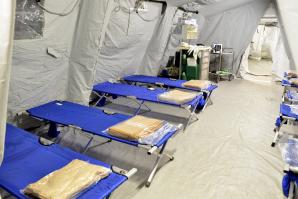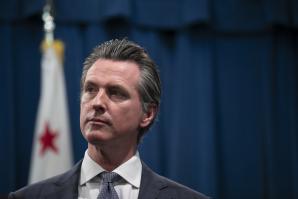As the number of people hospitalized in California with the coronavirus doubled in just four days, Gov. Gavin Newsom on Monday sent out an urgent call seeking help from the state’s 37,000 retired and part-time health care professionals.
Newsom issued an executive order that will temporarily allow retired doctors and nurses to return to work, broaden the duties that some nurses may perform and bring medical school and nursing students who are close to graduating into the workforce almost immediately.
Click here for more coronavirus coverage
Statewide, 1,432 people have been hospitalized with the virus, up from 746 four days earlier, Newsom said. Of those, 42% or 597 were in intensive care, compared with about 200 four days earlier.
Newsom, making the announcement on National Doctors Day, said he hoped that his appeal for the new California Health Corps would generate “thousands and thousands” of additional medical workers to respond to the pandemic.
“We are very, very hopeful with this effort that we will see a surge of individuals,” he said, urging qualified people to sign up for the program at healthcorps.ca.gov.
Newsom’s order allows the state to waive licensing and certification requirements for certain medical professionals through June 30th.
It gives the state the flexibility to allow doctors and nurses who have retired in the last five years, students who have nearly graduated from medical and nursing schools and others who are in the process of obtaining a license or getting relicensed to treat patients. The new workers would be paid and covered by malpractice insurance.
Health care advocates and experts say the governor’s order is vague so they are eager for details about what exactly will be allowed under the executive order. They said while it admirably aims to expand the workforce, it simply authorizes state agencies and licensing boards to make the final decision on what licensing and scope of practice regulations will be relaxed or waived for the time being.
“It’s opaque,” said Joanne Spetz, associate director of research at the Healthforce Center at UCSF. “Most of us who have been watching this expected there to be more clarity today about what is going to be allowed.
“Until the agencies provide that specificity for the workforce it’s unclear what is going to be permitted,” Spetz said. “Workers are going to need that guidance from a practical standpoint.”
The executive order leaves a lot of questions unanswered, said Scott Casanover, vice president of government affairs for West Coast University, a private nursing school with three campuses in Southern California.
Nursing students have to complete a certain number of hands-on clinical hours with patients to graduate. All of those hours were cut short in the last month as host organizations like hospitals began shutting down their programs or the schools pulled their students after the sheltering in place orders were issued.
“I’m glad that the governor turned his attention to the issue but he really didn’t make any decision in today’s order,” Casanover said. “He repeatedly says every second counts, every minute counts, but here we have the governor kicking the can down the road to the state agencies.”
The California Medical Association, which represents more than 50,000 physicians, supports the move by the governor, said Anthony York, spokesman for the organization.
“We understand that we all have to get out of our bunkers a little bit,” York said.
Sandra Hernandez, president and CEO of the California Health Care Foundation, praised the order, calling it “a thoughtful step that the governor and his team is putting in place.”
“The point here is to mobilize all available workforce in California, and I fully expect these agencies are ready to act and take the appropriate steps to deploy as many of our workforce as possible,” Hernandez said. “I’ve got to believe that all agencies will be playing their part.”
Hernandez said calling on the mature health care workforce will garner a large response, and including young near-graduates is equally important.
“They are very freshly trained and this is a younger workforce. Their training has been the most immediate and I think it was wise to deploy that workforce quickly into their respective professions as possible,” Hernandez said.
Newsom said the groups involved “put aside their differences” to agree to the program.
The expansion of the role of nurses has been particularly controversial in California in recent years. Nurse practitioners have been fighting to persuade the California Legislature to permit them “full scope” authority, which would allow them to evaluate and treat patients independently without direct physician oversight.
Under current law a doctor can oversee four nurse practitioners. York said the Dept. of Consumer Affairs, which licenses professions, said on a conference call Monday that it will allow for a higher number per doctor as needed by hospitals and clinics, which will have to apply for the waiver.
However, the medical association, he said, is still opposed to legislation intended to give nurse practitioners the ability to practice independently.
California’s attention had been on stockpiling protective gear such as masks, gloves and ventilators, and greatly expanding the number of hospital beds for patients with the virus as well as other health problems.
The Naval hospital ship Mercy, moored at the Port of Los Angeles, has begun to care for patients who are not infected with the coronavirus, and numerous field hospitals are being erected in parking lots and sports arenas.
But now staffing the burgeoning medical facilities has taken primacy as the number of people hospitalized, particularly in intensive care units, has surged.
Newsom said the state would need to quickly increase its hospital capacity by two-thirds to handle the anticipated rush of cases.
While the rate of infections is rising, officials are more concerned at the much faster pace of patients requiring hospitalization.
Mark Ghaly, secretary of the state Health and Human Services Agency, said current models project the need for an additional 50,000 hospital beds by the middle of May. That’s in addition to California’s current inventory of 75,000 licensed beds.
“Who better than those folks who are really close to being done to bring into the workforce now to essentially continue their clinical training with the help of experienced nurses or other health professionals,” Ghaly said.
Building the workforce is critical, but so is their protection. As more workers are brought to the front line, the state has to ensure that they are provided adequate personal protective gear, which has been a struggle, said Stephanie Roberson, government relations director at California Nurses Association.
“We can’t talk about workforce and how we prepare for a surge if our nurses and other health care workers are not protected at the bedside,” said Roberson.
Calling for almost-ready student nurses can ease the burden at hospitals, Roberson said, as long as they work under the direct supervision of experienced registered nurses.
“We absolutely can use our student nurses judiciously in this situation,” she said. “And at the same time they can still gain the clinical experience they need for graduation, that can happen right now.”
Nurses have regularly protested outside hospitals demanding more N95 respirators and other gear. An increase of medical staff will require that much more supplies, which the state is still sourcing.
Newsom said the state had distributed 32.6 million N95 masks, part of an estimated 100 million gloves, gowns, and other pieces of protective equipment officials are trying to procure, including as many as 10,000 ventilators.
He said the statewide social distancing edict has been successful, but when asked if the mandate that Caliornians stay at home was working to “flatten the curve” — epidemiologists’ holy grail of decreasing the rate of infections — he demurred.
The policy alone may not end the epidemic, Newsom said, “But we know what does work, and that’s physical distancing.”
Newsom would not specify the cost of the program, but said some if it would be borne by the federal government.
Some other states have already allowed for retirees and students to begin treating patients and allowed some nurses to perform tasks usually reserved for physicians.
At least 33 states have amended licensing requirements for health care workers, according to the National Council of State Legislatures.
For instance, Washington has allowed volunteer doctors and practitioners from other states to practice as long as they are in good standing in their home state. Florida is allowing licensed health care workers from elsewhere to temporarily provide care without a state license. Iowa is allowing doctors, nurses and physician assistants with inactive or lapsed licenses to practice.
CalMatters.org is a nonprofit, nonpartisan media venture explaining California policies and politics.
–
Stay up to date on the effects of the coronavirus on people and business in the Capital Region: Subscribe to the Comstock’s newsletter today.
Recommended For You

Newsom, Trump: More Beds, Masks, Equipment Ahead for Coronavirus
As California braced for an onslaught of desperately ill coronavirus patients, Gov. Gavin Newsom announced plans over the weekend to open two new hospitals, and President Donald Trump said the federal government will ship a number of mobile hospital units to the state, pay for National Guard deployments and deploy the San Diego-based naval hospital ship Mercy to Los Angeles.

California Ramps up Output of Ventilators as COVID-19 Cases Grow
Gov. Gavin Newsom expressed confidence Saturday that California has the capacity to produce enough ventilators to meet its projected needs in response to the coronavirus pandemic. But he cautioned that the state’s need could expand if the crisis worsens.



